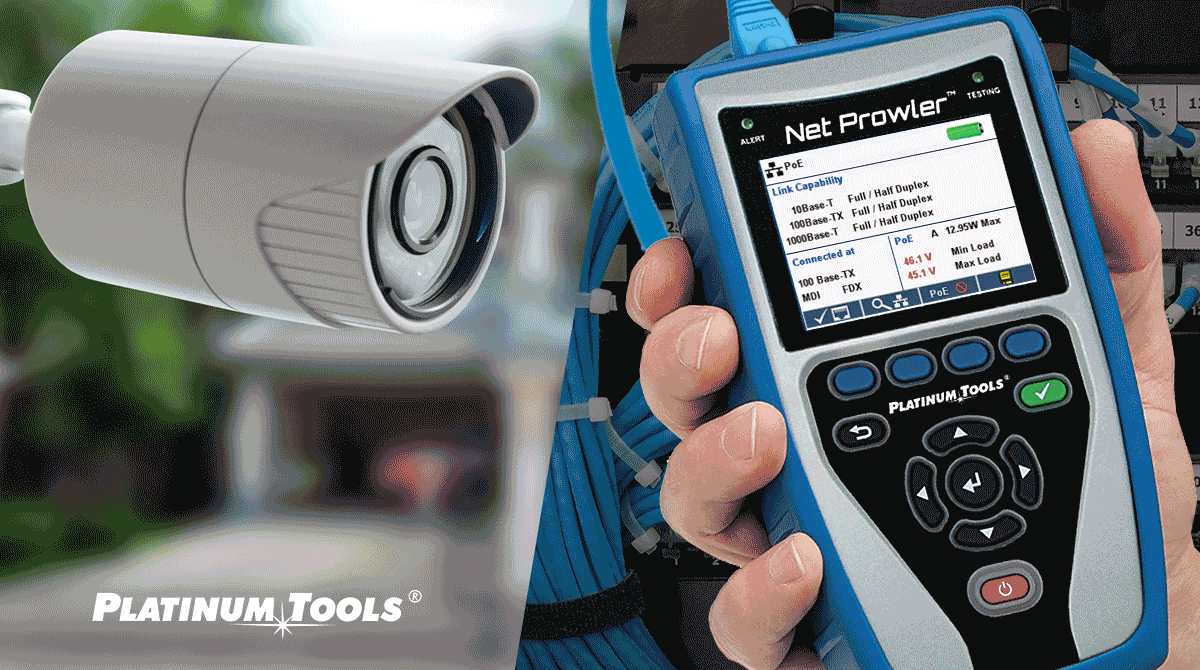
The wiring of security cameras has become much easier since the introduction of Power over Ethernet (PoE). This innovative method of powering internet capable devices means that no external power supply is needed and power is transferred over the Ethernet cable used to connect the IP camera to the system.
The system is simple, although some basic rules need to be followed to ensure that the camera receives power, and when something goes wrong, the only effective way of identifying what has happened is to use a digital network tester that’s capable of measuring PoE.
PoE Options
Two PoE options are available. Standard PoE provides a maximum of 12.95 watts at the device with a working voltage range that’s between 37 and 57 volts DC. Then there is a higher specification PoE plus, often written PoE+, that provides 25.5 watts at a voltage between 42.5 and 57 volts at the camera. Two operating modes are possible. Mode A supplies positive power on pins 1 and 2 and negative power on pins 3 and 6, while mode B uses pins 4 and 5 for positive power and pins 7 and 8 for negative power.
Two types of power supply are available. There is the midspan injector that’s connected between the switch and the camera. Midspan power is limited to 12.95 watts and only operates in mode B, using spare pairs that are not needed for 10Base-TX and 100Base-TX Ethernet. Alternatively, power can be supplied by PoE enabled routers and switches. This is compatible with 1000Base-TX Ethernet speeds and the power is supplied on data lines.
Practical PoE Concerns
PoE enabled devices interact with PoE power supplies so power is only supplied when a compatible device is connected. The actual power available at the power supply is slightly higher than the above specifications to overcome the resistance of the Ethernet cable. For PoE it is 15.4 watts and PoE+ it’s 30 watts. It’s also worth noting that there are four power classes providing a maximum of 4, 7, 15.4 or 30 watts at the power supply. If the cable is too long or if poor quality cable is used, it’s possible that insufficient power will be available to power the camera, and it will shut down; it is best to use solid CAT6 cable for PoE+ due to its higher current carrying capacity.
Using a Digital Network Tester
The easiest way to commission PoE is to use digital network testers like the Net Prowler™, Cable Prowler™ or Net Chaser™ available from Platinum Tools. If one of these Network Testers is connected to the Ethernet cable supplying the IP camera, the availability of PoE, the maximum power available as well as the supply voltage range and power supply mode can be established. The testers will also identify which pairs are transmitting the PoE voltage, test the link speed and its capability.
The Net Prowler supports IPV4 and IPV6 protocols, can ping IP and URL addresses and establish whether CDP or LLDP protocols are used. Other useful network capabilities are VLAN identification and the ability to map networks. When mapping, the tester will show MAC addresses, device names and their IP address.
Useful fault-finding capabilities include link light identification to identify which port the cable is connected to as well as a tone generator that, when used with an optional detector, can trace individual cores. The Cable Prowler and Net Prowler identify open circuits, short circuits and incorrect RJ45 connections, or splits as they are commonly known, as well as accurately measure the length of the cable or the distance to a fault.







